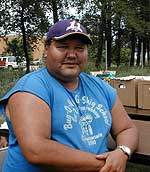By Tom Robertson
Minnesota Public Radio
July 30, 2002
efore the arrival of white settlers, lacrosse was the most popular team sport on the North American continent. Indian tribes on the East Coast never stopped playing the ball game. But the tradition faded for many Midwestern tribes. On the Leech Lake Reservation in northern Minnesota, a new generation is learning the game. Some see it as an important step in preserving Ojibwe heritage.
| |
|
|
|
||
About a dozen members of the Leech Lake Boys Lacrosse Club form a circle in the hot sun. They're limbering up for practice. For a few of the boys, it's an introduction to a game played by their ancestors. Tom Jenkins is in his second year of play. He learned about the game from books.
"I did a couple of reports on it during school and read about it, and saw some pictures of how they played and what it was like," said Jenkins. "I'm glad it's coming back."
Teammate Tim Bebeau is a club veteran. He was there when it started in 1998.
"It's something different, a lot of running," he said. "It's good that it's coming back. And it's fun to play something that they played back in the (old) day(s)."
For early Ojibwe and Lakota communities, lacrosse was a favorite pastime. It was an athletic contest of great skill, pride and spiritual significance. But Minnesota tribes stopped playing lacrosse in the early 1900s. Historians blame boarding schools and other government and religious assimilation policies.
| |
|
|
|
||
Club coach Jerry Morgan is a Leech Lake band member. He says he didn't even know what lacrosse was until he was an adult. Morgan says there are few people on the reservation who understand the game or its cultural significance.
"It goes back to before World War II, about 70 years (ago was) the last time it was played here at Leech Lake," Morgan said. "So it's been lost for generations. ... After the war, upon returning home, they all picked up bats and gloves and started playing baseball."
Morgan says indigenous people believed lacrosse was given to them by the Creator. They played it to help in the healing process, to settle disputes, to prepare for war, and for spiritual development. Morgan says he wants his people to remember those traditions.
"We've taken the time with some of the elders with different feasts and ceremonies," he said. "One thing we do when we play our home games is, we have a traditional drum. And we were gifted last year with an eagle staff, so we have some eagle feathers. And so we're going to bring those out when we do our home games."
On one practice day, St. Cloud State lacrosse alumni Craig Fuller helped the team with basic skills. Fuller is a Mohawk Indian from New York. Some eastern tribes have maintained their lacrosse tradition. Fuller's been playing lacrosse since he was three.
|
"When you're holding on to that stick, you're holding on to your life and you're holding on to your culture."
- Leech Lake boys lacrosse coach Jerry Morgan |
"I think this is huge, bringing lacrosse back here to this area," said Fuller. "We have about 12, 13 kids here, who have maybe never played lacrosse. Some of them have, but they're out here wanting to learn the sport. And I think it's great to bring this back. This is part of the culture here. I guess it's like anything in American Indian culture. If you lose it, to bring it back is something very, very important."
Coach Jerry Morgan says other Minnesota Ojibwe tribes are interested in reviving lacrosse, but it's tough finding coaches who know the sport. Until then, the Leech Lake Boys Lacrosse Club has to travel to Wisconsin or Manitoba to find competition. Morgan says the lacrosse revival is another step toward healing a community that's been oppressed for years.
"When you're holding on to that stick, you're holding on to your life and you're holding on to your culture," said Morgan.
While lacrosse is a fledgling sport on Minnesota Indian reservations, its popularity is growing. Membership in the Minnesota Lacrosse Association is averaging 30 to 45 percent growth per year. There are now dozens of high school teams. Last year, girls high school lacrosse was elevated to varsity status by the Minnesota State High School League. The boys hope for the same thing this fall.
More Information

